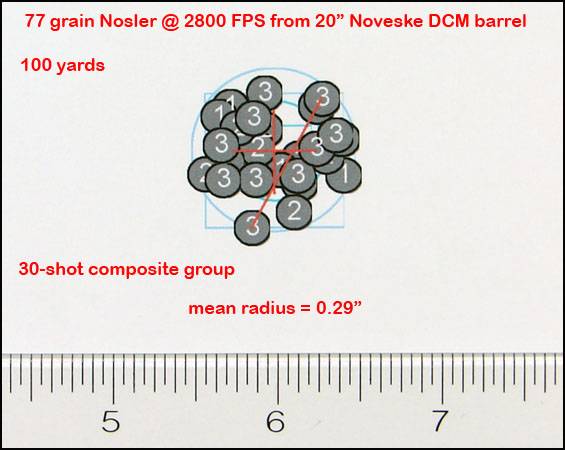Noveske 20” HBAR Accuracy Evaluation

This 20” barrel is one of Noveske’s 416R stainless steel, button rifled barrels. The exterior of the barrel has a bead-blasted finish. Unlike most of Noveske’s other stainless-steel barrels, this barrel has an HBAR profile (not a medium contour profile.) This barrel also differs from most of Noveske’s other stainless-steel barrels in that it has a standard length gas block journal (not a 1” gas block journal). The gas block journal has a diameter of 0.750”.
The barrel extension has M4 feed-ramps and I paired this barrel with a LaRue upper receiver that also has M4 feed ramps. The barrel was free-floated in a 13.2” Larue legacy picatinny handguard.

The chamber of this barrel is the original proprietary Noveske Match Mod 0 chamber designed by John Noveske. The chamber “was developed to fire MK262 Mod 1 on AUTO in hot environments" and still produce better accuracy/precision than a 5.56mm NATO chamber. The barrel stamp reads:
Noveske 5.56 NMm0 7PT
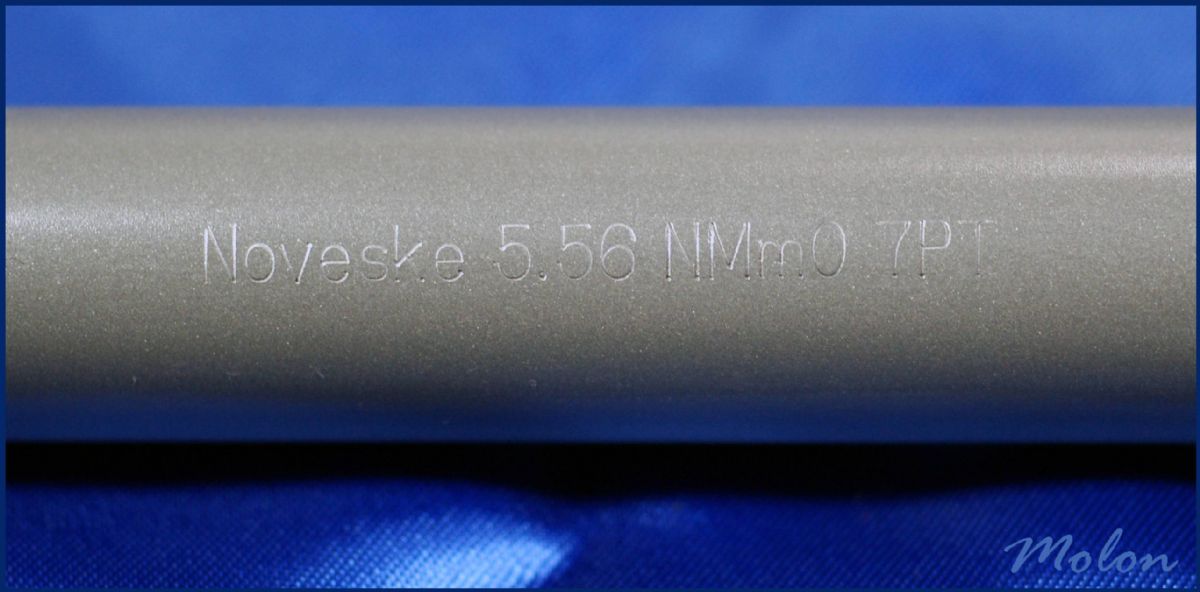
This barrel has a 1:7” twist and has shot every bullet weight from 40 grains to 77 grains quite well. Unlike the Noveske cold hammer forged barrels that have traditional rifling, the Noveske stainless steel barrels utilize 5R polygonal rifling.
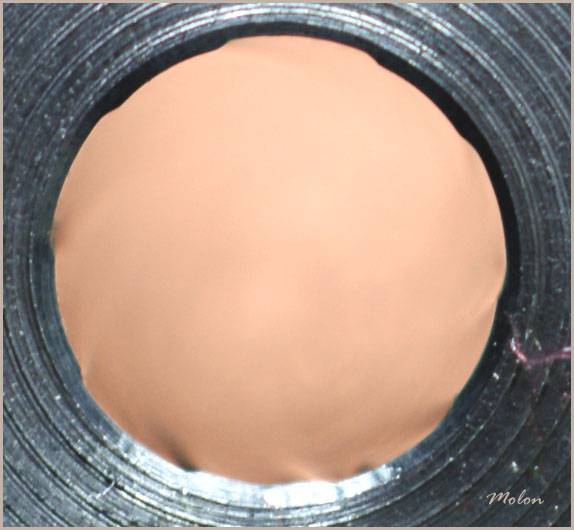
Gen 1 rifling . . .
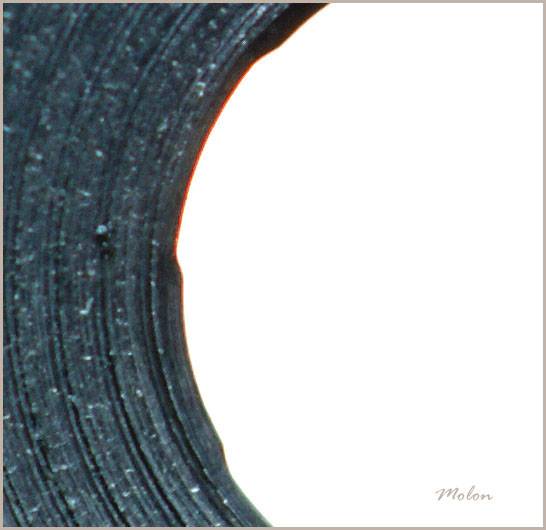
Gen 2 rifling . . .
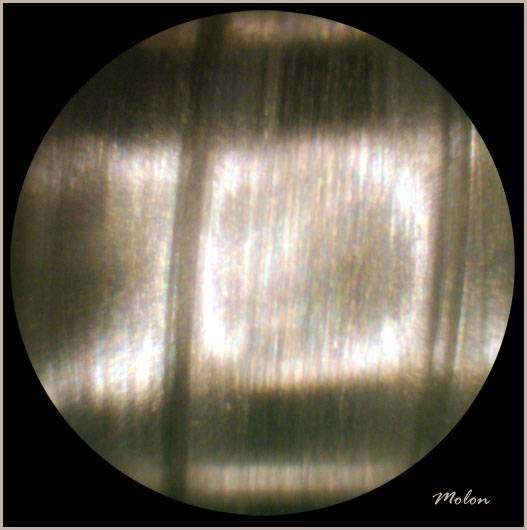
Accuracy/precision testing of this barrel was conducted after a 200 round break-in period. All shooting was done from my bench-rest set-up following my usual protocol. This accuracy evaluation used statistically significant shot-group sizes and every single shot in a fired group was included in the measurements. There was absolutely no use of any group reduction techniques (e.g. fliers, target movement, Butterfly Shots).
The shooting set-up will be described in detail below. As many of the significant variables as was practicable were controlled for. Pictures of shot-groups are posted for documentation.
All shooting was conducted from a concrete bench-rest from a distance of 100 yards (confirmed with a laser rangefinder.) The free-float hand-guard of the rifle rested in a Sinclair Windage Benchrest, while the stock of the rifle rested in a Protektor bunny-ear rear bag. Sighting was accomplished via a Leupold VARI-X III set at 25X magnification and adjusted to be parallax-free at 100 yards. A mirage shade was used. Wind conditions on the shooting range were continuously monitored using a Wind Probe. The set-up was very similar to that pictured below.
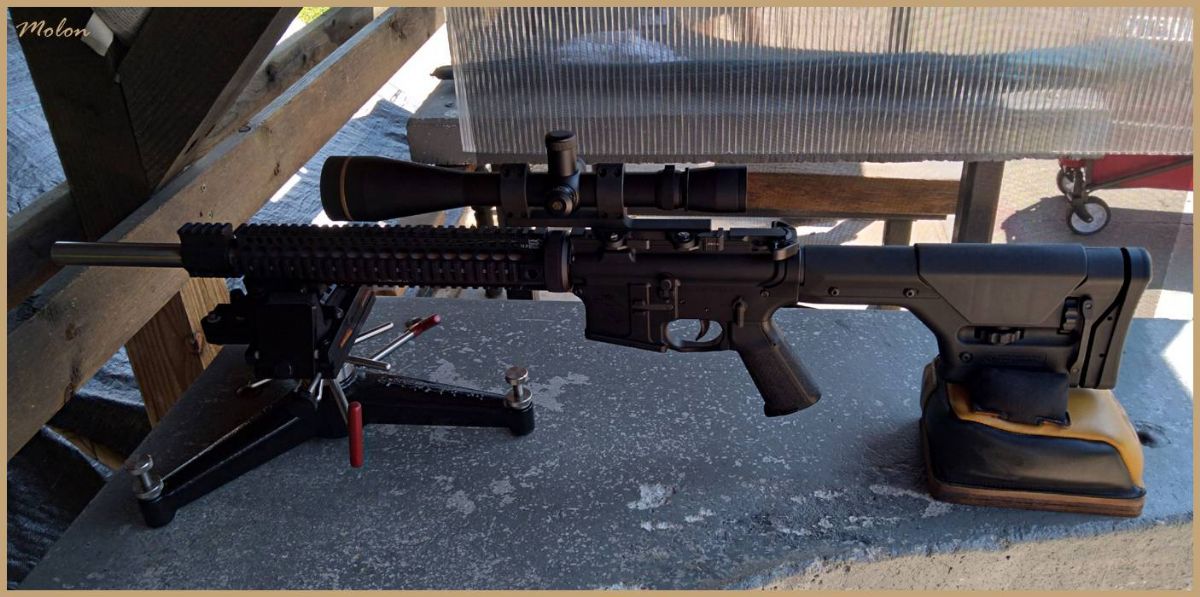
The Wind Probe . . .
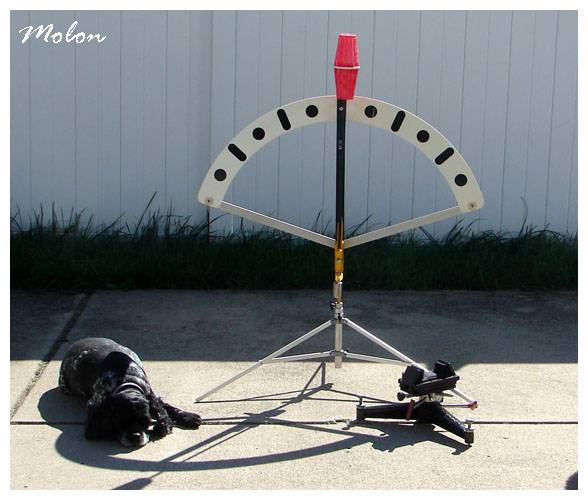
I developed a hand-load for this barrel using the Sierra 55 grain BlitzKing. I used my Accuracy Node Detection Technique to develop this load.
Molon's Accuracy Node Detection Technique
WARNING!
Reloading is an inherently dangerous activity. The information provided here is for educational purposes only. It is not intended to be used for the actual loading of ammunition by the reader. No warranty, guarantee or assurance that these loads are safe is stated, suggested or implied nor should any be inferred. Usage of this information for the actual loading of ammunition may result in malfunctions, damage and destruction of property and grave injury or death to beings human in nature or otherwise. Don't even view this information in the presence of children or small animals.
As mentioned above, the projectile used for this example was the Sierra 55 grain BlitzKing and the powder used was VihtaVuori N133. The following eight powder charges were used:
Target #1 - 24.0 grains
Target #2 – 24.2 grains
Target #3 – 24.4 grains
Target #4 – 24.6 grains
Target #5 – 24.8 grains
Target #6 – 25.0 grains
Target #7 – 25.2 grains
Target #8 – 25.4 grains
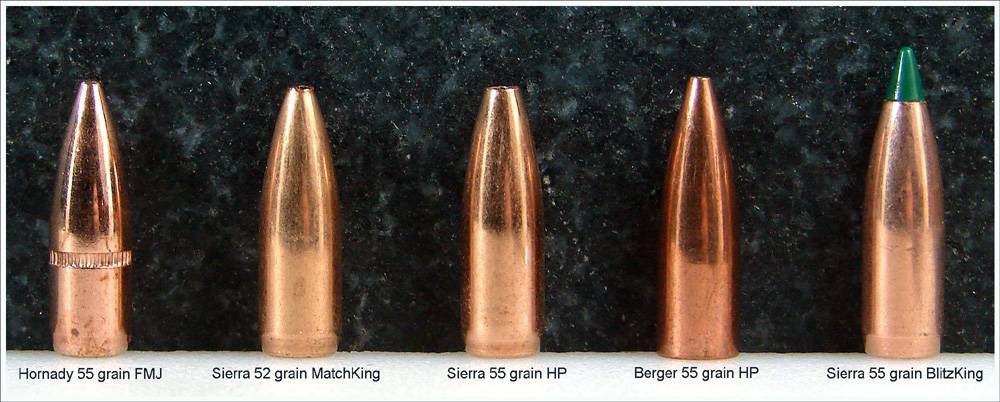
VihtaVuori N133
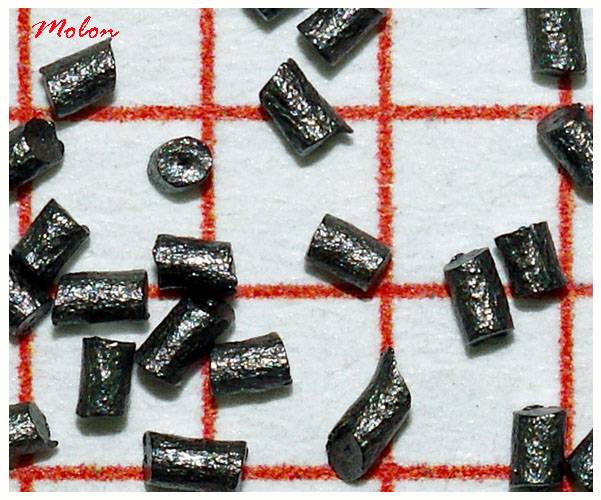
Testing was conducted at a distance of 100 yards. Eight 5-shot groups were fired in a round-robin manner to obtain six sets of three consecutive targets. These six sets of three consecutive targets were over-layed on each other using the On Target TDS software program to form six 15-shot composite groups and the mean radius was used to find the accuracy node. The results are shown in the graphics below.
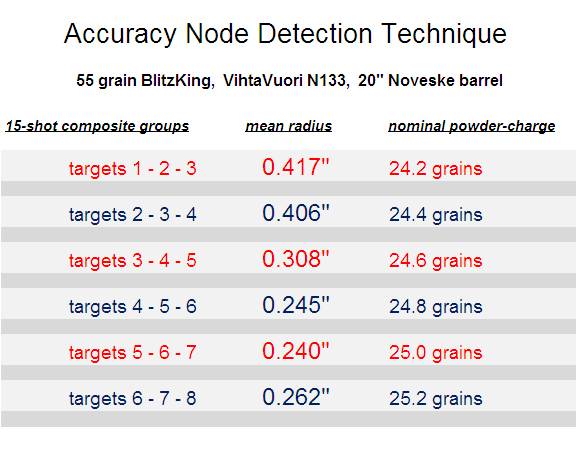
Groups #5, #6 and #7 over-layed . . .
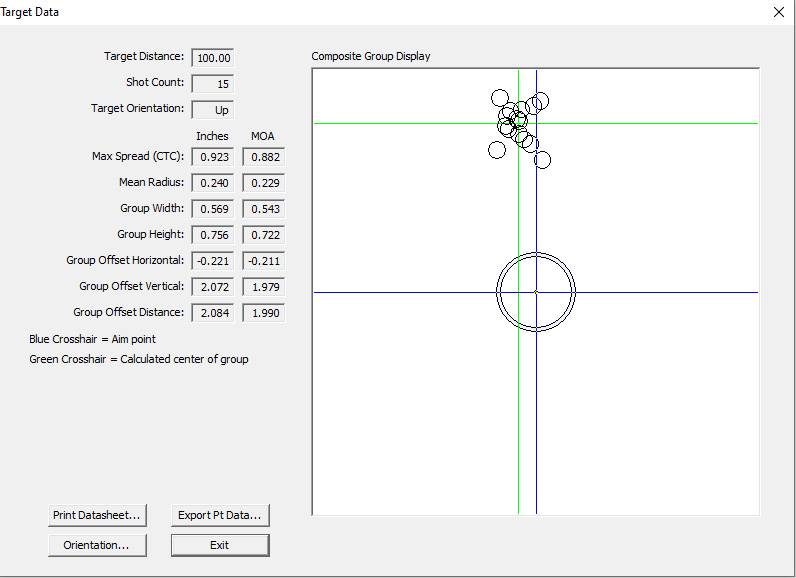
To reiterate, the 15-shot composite group pictured above was fired in a round robin manner with rounds charged with three different powder charges. The extreme spread for the 15-shot composite group was 0.88 MOA. The middle powder charge for the 15-shot composite group was 25.0 grains.
An individual 10-shot group loaded with the nominal powder charge of 25.0 grains had an extreme spread of 0.74”.
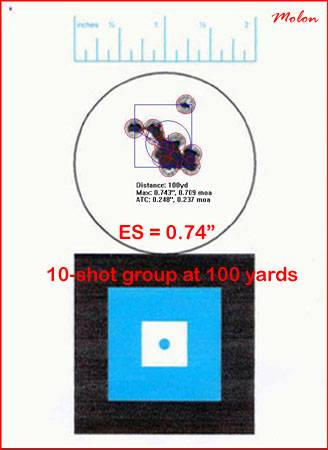
Five 10-shot groups of the 55 grain BlitzKing loaded with the nominal powder charge of 25.0 grains fired in a row from the 20” Noveske barrel at a distance of 100 yards were overlayed using RSI Shooting Lab to form a 50-shot composite group. The mean radius for the 50-shot composite group was 0.28”.
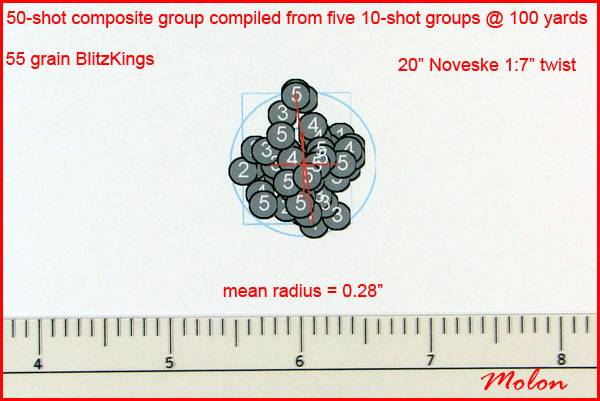
Lastly, for any Internet Commandos in our viewing audience today, here’s a pic of a sub ¼ MOA group fired from the 20” Noveske barrel at 100 yards. The group has an extreme spread of 0.175”.
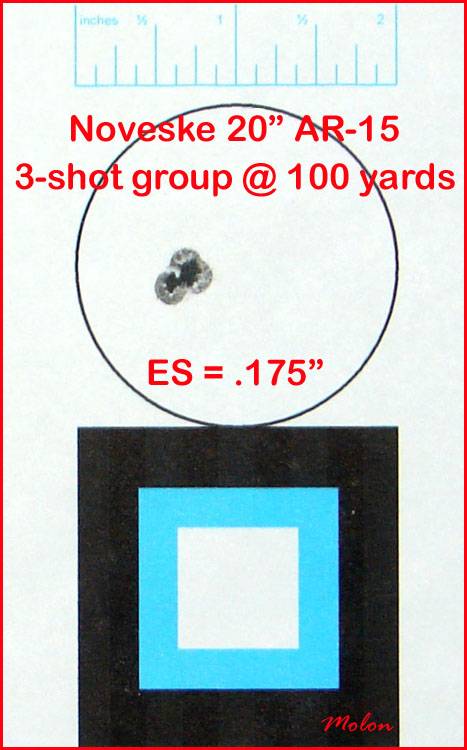

….
ETA This particular barrel was purchased prior to the untimely death of John Noveske.

This 20” barrel is one of Noveske’s 416R stainless steel, button rifled barrels. The exterior of the barrel has a bead-blasted finish. Unlike most of Noveske’s other stainless-steel barrels, this barrel has an HBAR profile (not a medium contour profile.) This barrel also differs from most of Noveske’s other stainless-steel barrels in that it has a standard length gas block journal (not a 1” gas block journal). The gas block journal has a diameter of 0.750”.
The barrel extension has M4 feed-ramps and I paired this barrel with a LaRue upper receiver that also has M4 feed ramps. The barrel was free-floated in a 13.2” Larue legacy picatinny handguard.

The chamber of this barrel is the original proprietary Noveske Match Mod 0 chamber designed by John Noveske. The chamber “was developed to fire MK262 Mod 1 on AUTO in hot environments" and still produce better accuracy/precision than a 5.56mm NATO chamber. The barrel stamp reads:
Noveske 5.56 NMm0 7PT

This barrel has a 1:7” twist and has shot every bullet weight from 40 grains to 77 grains quite well. Unlike the Noveske cold hammer forged barrels that have traditional rifling, the Noveske stainless steel barrels utilize 5R polygonal rifling.

Gen 1 rifling . . .

Gen 2 rifling . . .

Accuracy/precision testing of this barrel was conducted after a 200 round break-in period. All shooting was done from my bench-rest set-up following my usual protocol. This accuracy evaluation used statistically significant shot-group sizes and every single shot in a fired group was included in the measurements. There was absolutely no use of any group reduction techniques (e.g. fliers, target movement, Butterfly Shots).
The shooting set-up will be described in detail below. As many of the significant variables as was practicable were controlled for. Pictures of shot-groups are posted for documentation.
All shooting was conducted from a concrete bench-rest from a distance of 100 yards (confirmed with a laser rangefinder.) The free-float hand-guard of the rifle rested in a Sinclair Windage Benchrest, while the stock of the rifle rested in a Protektor bunny-ear rear bag. Sighting was accomplished via a Leupold VARI-X III set at 25X magnification and adjusted to be parallax-free at 100 yards. A mirage shade was used. Wind conditions on the shooting range were continuously monitored using a Wind Probe. The set-up was very similar to that pictured below.

The Wind Probe . . .

I developed a hand-load for this barrel using the Sierra 55 grain BlitzKing. I used my Accuracy Node Detection Technique to develop this load.
Molon's Accuracy Node Detection Technique
WARNING!
Reloading is an inherently dangerous activity. The information provided here is for educational purposes only. It is not intended to be used for the actual loading of ammunition by the reader. No warranty, guarantee or assurance that these loads are safe is stated, suggested or implied nor should any be inferred. Usage of this information for the actual loading of ammunition may result in malfunctions, damage and destruction of property and grave injury or death to beings human in nature or otherwise. Don't even view this information in the presence of children or small animals.
As mentioned above, the projectile used for this example was the Sierra 55 grain BlitzKing and the powder used was VihtaVuori N133. The following eight powder charges were used:
Target #1 - 24.0 grains
Target #2 – 24.2 grains
Target #3 – 24.4 grains
Target #4 – 24.6 grains
Target #5 – 24.8 grains
Target #6 – 25.0 grains
Target #7 – 25.2 grains
Target #8 – 25.4 grains

VihtaVuori N133

Testing was conducted at a distance of 100 yards. Eight 5-shot groups were fired in a round-robin manner to obtain six sets of three consecutive targets. These six sets of three consecutive targets were over-layed on each other using the On Target TDS software program to form six 15-shot composite groups and the mean radius was used to find the accuracy node. The results are shown in the graphics below.

Groups #5, #6 and #7 over-layed . . .

To reiterate, the 15-shot composite group pictured above was fired in a round robin manner with rounds charged with three different powder charges. The extreme spread for the 15-shot composite group was 0.88 MOA. The middle powder charge for the 15-shot composite group was 25.0 grains.
An individual 10-shot group loaded with the nominal powder charge of 25.0 grains had an extreme spread of 0.74”.

Five 10-shot groups of the 55 grain BlitzKing loaded with the nominal powder charge of 25.0 grains fired in a row from the 20” Noveske barrel at a distance of 100 yards were overlayed using RSI Shooting Lab to form a 50-shot composite group. The mean radius for the 50-shot composite group was 0.28”.

Lastly, for any Internet Commandos in our viewing audience today, here’s a pic of a sub ¼ MOA group fired from the 20” Noveske barrel at 100 yards. The group has an extreme spread of 0.175”.


….
ETA This particular barrel was purchased prior to the untimely death of John Noveske.
Last edited:


